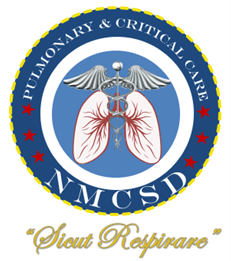Fellows participate in the weekly Friday morning half-day Mega Clinic during their rotations on the NMCSD Consult service as well as during elective rotations at NMCSD. This clinic provides fellows with the opportunity to provide care for Active-Duty patients with a wide variety of pulmonary and sleep disorders. A total of at least 9 months of Active-Duty Clinic over the course of 36 months of training is required. The consult attending serves as the primary proctor for these clinics. Refer to the clinic matrix grid to determine Active-Duty assignments during rotations. The goals and objectives of the clinic can be found in the Active-Duty Clinic description at the end of this section.
- Mega Clinic Pulmonary Description
- Rotation Director: AEA ALEX, M.D.
- Rotation Location: Naval Medical Center San Diego
- Rotation Duration: Throughout Training. Trainees/month: Variable
Educational Purpose and Rotation Description:
The pulmonary outpatient active-duty clinic offers the fellow the opportunity to evaluate, diagnose, and treat a range of pulmonary diseases seen in active-duty military members. The active-duty clinic is designed to facilitate rapid referral and evaluation of military members from the Southwest United States and Pacific Rim who require subspecialty pulmonary consultation. All staff physicians, the pulmonary fellow on the inpatient consult service, rotating residents/interns/students, research fellows and fellows not engaged in other clinical service responsibilities are expected to participate. Pulmonary function tests, chest radiographs, and lab studies are conducted during the clinic and are available for physician review. Patients requiring follow-up are generally added to the staff or fellow’s continuity clinic rather than returned to the active-duty clinic. This clinic experience will enhance your expertise in evaluating dyspnea, chronic cough, basic asthma evaluation and management, as well as basic sleep-disordered breathing.
Rotation Objectives:
- Acquire knowledge and clinical experience in the following clinical areas:
- Obstructive lung diseases, which include asthma, bronchitis, emphysema, bronchiectasis, and cystic fibrosis.
- Primary and metastatic pulmonary malignancies.
- Pulmonary infections such as tuberculosis, fungal infections, and those happening in immunocompromised hosts.
- Diffuse interstitial lung disease.
- Pulmonary vascular diseases like primary and secondary pulmonary hypertension and vasculitis, and pulmonary hemorrhage syndromes.
- Occupational and environmental lung diseases.
- Iatrogenic respiratory diseases, including those induced by drugs.
- Acute lung injuries, including those caused by radiation, inhalation, and trauma.
- Pulmonary manifestations of systemic diseases, including collagen vascular diseases primarily affecting other organs.
- Respiratory failures, including adult respiratory distress syndrome, acute and chronic respiratory failure in obstructive lung diseases, and neuromuscular respiratory drive disorders.
- Disorders affecting the pleura and the mediastinum.
- Genetic and developmental disorders of the respiratory system.
- Sleep disorders.
- Pulmonary issues related to pregnancy.
- Acquire knowledge about the indications, contraindications, complications, and limitations of, and competency in performing the following procedures:
- Pulmonary function tests for assessing respiratory mechanics, gas exchange, and respiratory drive. These include spirometry, flow volume studies, lung volumes, diffusing capacity, arterial blood gas analysis, and exercise studies.
- Diagnostic and therapeutic procedures, which include thoracentesis, pleural biopsy, flexible fiberoptic bronchoscopy, and related procedures.
- Examination and interpretation of sputum, bronchopulmonary secretions, pleural fluid or tissue, and lung tissue for infectious agents; also, cytology and histopathology.
- Inhalation challenge studies.
- Percutaneous needle aspiration and/or cutting lung biopsy.
- Acquire knowledge of and the ability to interpret the following diagnostic studies and data pertaining to:
- Chest roentgenograms
- Computed axial tomograms.
- Radionuclide scans
- Pulmonary angiograms
- Other radiologic procedures
- Sleep studies
- Gain additional knowledge, skills, attitudes, and educational experience in the core competency areas of patient care, medical knowledge, practice-based learning, interpersonal and communication skills, professionalism, and systems-based practice by:
- Participating in quality improvement activities, including chart review.
- Returning phone messages in a timely manner.
- Informing patients of test results promptly.
- Avoiding discussion of patients in public areas.
- Obtaining informed consent for all invasive procedures.
- Making appropriate arrangements for patient follow-up during periods of unavailability (i.e., leave and TAD).
- Utilizing the internet and computer search strategies to obtain the latest diagnostic and treatment recommendations for patients.
- Clearly communicating consultative recommendations in writing (and in person when appropriate) to requesting physicians.
- Learning and applying hospital and national regulations regarding patient privacy (HIPAA).
- Completing clinic notes/consultations promptly (same day) and returning them to medical records so that other physicians have access.
- Following hospital guidelines regarding interaction with pharmaceutical representatives and medical equipment vendors, avoiding even the appearance of impropriety.
- Learning and applying hospital and national clinical guidelines/pathways for common pulmonary diseases.
- Looking for and identifying socioeconomic and language barriers to medical care.
- Asking about tobacco use (including smokeless), encouraging cessation, and enrolling patients in effective cessation courses.
- Keeping abreast of current literature, which includes active participation in journal clubs.
Learning Locations and Instructional Methods:
Direct Patient Care:
- Pulmonary Department, 3rd Floor, Building 3
- Procedure Suite, 3rd Floor, Building 3
- Pulmonary Function Test (PFT) Lab, 3rd Floor, Building 3
Recommended Reading:
- Fishman’s Pulmonary Diseases and Disorders, Third Edition, McGraw-Hill
- Textbook of Respiratory Medicine by Murray and Nadel, W.B. Saunders
- Pleural Diseases, Fourth Edition, by Light
- Principles and Practice of Sleep Medicine, Third Edition, by Kryger, W.B. Saunders
- Principles of Exercise Testing, Third Edition, by Wasserman, Lippincott
Evaluation:
Trainees will undergo an ongoing assessment by the relevant staff. At the close of each quarter, the Program Director will issue a written review of each fellow’s overall performance and effectiveness in the active duty and continuity clinics.
